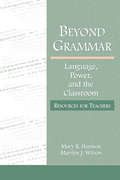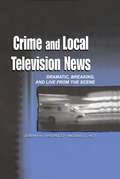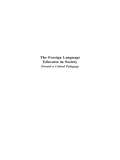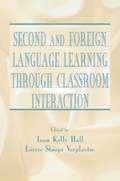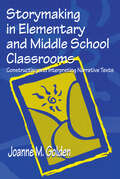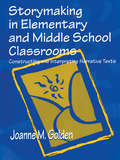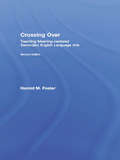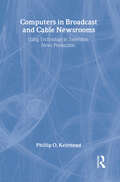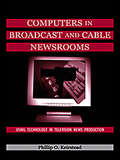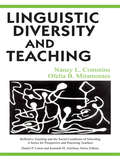- Table View
- List View
Beyond Grammar: Resources for Teachers
by Mary R. Harmon Marilyn J. WilsonBeyond Grammar: Language, Power, and the Classroom asks readers to think about the power of words, the power of language attitudes, and the power of language policies as they play out in communities, in educational institutions, and in their own lives as individuals, teachers, and participants in the larger community. Each chapter provides extended discussion of a set of critical language issues that directly affect students in classrooms: the political nature of language, the power of words, hate language and bullying, gender and language, dialects, and language policies. Written for pre-service and practicing teachers, this text addresses how teachers can alert students to the realities of language and power--removing language study from a “neutral” corner to situate it within the context of political, social, and cultural issues. Developing a critical pedagogy about language instruction can help educators understand that classrooms can either maintain existing inequity or address and diminish inequity through critical language study. A common framework structures the chapters of the text: * Each chapter begins with an overview of the language issue in question, and includes references for further research and for classroom use, and provides applications for classroom teachers.* Numerous references to the popular press and the breadth of language issues found therein foreground current thought on socio-cultural language issues, attitudes, standards, and policies found in the culture(s) at large.* References to current and recent events illustrate the language issue’s importance, cartoons address the issue, and brief “For Thought” activities illustrate the point being discussed and extend the reader’s knowledge and awareness.* “Personal Explorations” ask readers to go beyond the text to develop further understanding; “Teaching Explorations” ask teachers to apply chapter content to teaching situations. Beyond Grammar: Language, Power, and the Classroom is intended for undergraduate and master’s level courses that address literacy education, linguistics, and issues of language and culture.
The Story Performance Handbook
by R. Craig RoneyThe Story Performance Handbook provides specific, detailed information to help adults develop basic skills in reading aloud, mediated storytelling, and storytelling. Organized sequentially, each chapter moves the reader from the easiest (reading aloud picture books) to the most difficult (creating your own stories for telling) storytelling experience, cumulatively building story performance skill in selecting, preparing, and delivering stories and poetry to audiences. This structure allows individuals to begin reading at various points depending on their prior experience with story performance. The text includes several features that make learning to perform stories and poetry easy to understand and manage: * Explicit, thorough advice avoids confusion, such as how to select, prepare, and deliver stories and poetry via reading aloud, mediated storytelling, and storytelling. * The sequential chapter organization, progressing from easiest to most difficult, and Developmental and Culminating Activities at the end of each skill chapter, enable this text to be used either independently or in conjunction with courses or workshops in story performance. * Unique among story performance texts, instruction is based not only on the author's own extensive experience but also on empirical research related to teaching adults to tell stories. * Specific information is easily located throughout the text: Processes are presented in bold type, numbered sequentially and, at the end of specific chapters, skill building activities are provided. Figures (which provide additional detailed information) are boxed. Examples of processes are highlighted with background shading.
Crime and Local Television News: Dramatic, Breaking, and Live From the Scene
by Jeremy H. Lipschultz Michael L. HiltThis volume offers an analysis of crime coverage on local television, exploring the nature of local television news and the ongoing appeal of crime stories. Drawing on the perspectives of media studies, psychology, sociology, and criminology, authors Jeremy H. Lipschultz and Michael L. Hilt focus on live local television coverage of crime and examine its irresistibility to viewers and its impact on society's perceptions of itself. They place local television news in its theoretical and historical contexts, and consider it through the lens of legal, ethical, racial, aging, and technological concerns. In its comprehensive examination of how local television newsrooms around the country address coverage of crime, this compelling work discusses such controversial issues as the use of crime coverage to build ratings, and considers new models for reform of local TV newscasts. The volume includes national survey data from news managers and content analyses from late night newscasts in a range of markets, and integrates the theory and practice of local television news into the discussion. Lipschultz and Hilt also project the future of local television news and predict the impact of social and technological changes on news. As a provocative look at the factors and forces shaping local news and crime coverage, Crime and Local Television News makes an important contribution to the discussions taking place in broadcast journalism, mass communication, media and society, and theory and research courses. It will also interest all who consider the impact of local news content and coverage.
Crime and Local Television News: Dramatic, Breaking, and Live From the Scene
by Jeremy H. Lipschultz Michael L. HiltThis volume offers an analysis of crime coverage on local television, exploring the nature of local television news and the ongoing appeal of crime stories. Drawing on the perspectives of media studies, psychology, sociology, and criminology, authors Jeremy H. Lipschultz and Michael L. Hilt focus on live local television coverage of crime and examine its irresistibility to viewers and its impact on society's perceptions of itself. They place local television news in its theoretical and historical contexts, and consider it through the lens of legal, ethical, racial, aging, and technological concerns. In its comprehensive examination of how local television newsrooms around the country address coverage of crime, this compelling work discusses such controversial issues as the use of crime coverage to build ratings, and considers new models for reform of local TV newscasts. The volume includes national survey data from news managers and content analyses from late night newscasts in a range of markets, and integrates the theory and practice of local television news into the discussion. Lipschultz and Hilt also project the future of local television news and predict the impact of social and technological changes on news. As a provocative look at the factors and forces shaping local news and crime coverage, Crime and Local Television News makes an important contribution to the discussions taking place in broadcast journalism, mass communication, media and society, and theory and research courses. It will also interest all who consider the impact of local news content and coverage.
The Foreign Language Educator in Society: Toward A Critical Pedagogy
by Timothy G. Reagan Terry A. OsbornThis text brings together two significant domains of educational practice: foreign language education and critical pedagogy--linking them in a way that can help foreign language educators develop a critical awareness of the nature, purposes, and challenges facing foreign language pedagogy. Unique among texts in the field, this is the first to deal explicitly with the social, political, ideological, and economic aspects of language, language learning, and language teaching in our society and to connect the practice of foreign language education with these critical, and crucial, aspects of language and language use. The Foreign Language Educator in Society: Toward A Critical Pedagogy: *emphasizes what teachers and future teachers of foreign languages in this country ought to know and understand about language-- language attitudes, practices, rights, and policy-- and related issues; *focuses on helping students to move beyond pragmatic pedagogical concerns to the social and political concerns relevant to their teaching; and *provides students with the opportunity to develop critical perspectives on the central facets of the language education process. Intended for foreign language education programs at both basic and advanced levels, as well as courses in critical pedagogy, critical language awareness, sociolinguistics, and social and cultural foundations of education, the text provides helpful pedagogical features to direct the reader in applying the content of each chapter to his or her own context.
The Foreign Language Educator in Society: Toward A Critical Pedagogy
by Timothy G. Reagan Terry A. OsbornThis text brings together two significant domains of educational practice: foreign language education and critical pedagogy--linking them in a way that can help foreign language educators develop a critical awareness of the nature, purposes, and challenges facing foreign language pedagogy. Unique among texts in the field, this is the first to deal explicitly with the social, political, ideological, and economic aspects of language, language learning, and language teaching in our society and to connect the practice of foreign language education with these critical, and crucial, aspects of language and language use. The Foreign Language Educator in Society: Toward A Critical Pedagogy: *emphasizes what teachers and future teachers of foreign languages in this country ought to know and understand about language-- language attitudes, practices, rights, and policy-- and related issues; *focuses on helping students to move beyond pragmatic pedagogical concerns to the social and political concerns relevant to their teaching; and *provides students with the opportunity to develop critical perspectives on the central facets of the language education process. Intended for foreign language education programs at both basic and advanced levels, as well as courses in critical pedagogy, critical language awareness, sociolinguistics, and social and cultural foundations of education, the text provides helpful pedagogical features to direct the reader in applying the content of each chapter to his or her own context.
Second and Foreign Language Learning Through Classroom Interaction
by Joan Kelly Hall Lorrie Stoops VerplaetseThis volume brings together the current theoretical interest in reconceptualizing second and foreign language learning from a sociocultural perspective on language and learning, with practical concerns about second and foreign language pedagogy. It presents a set of studies whose focus is on the empirical description of particular practices constructed in classroom interaction that promote the learning of a second or foreign language. The authors examine in detail the processes by which the learning of additional languages is accomplished in the interaction of a variety of classrooms and in a variety of languages. Not only will the findings from the studies reported in this volume help to lay a foundation for the development of a more expansive, sociocultural model of second and foreign language learning, but on a more practical level they will help language educators in creating a set of principles for identifying and sustaining classroom interactional practices that foster additional language development. The volume is distinguished in three ways: * Following a Vygotskyan perspective on development, the studies assume that language learning is a fundamentally pragmatic enterprise, intrinsically linked to language use. This breaks from a more traditional understanding of second and foreign language learning, which has viewed learning and use as two distinct phenomena. The importance of classroom interaction to additional language development is foregrounded. * The investigations reported in this book are distinguished by their methodological approach. Because language learning is assumed to be a situated, context-sensitive, and dynamic process, the studies do not rely on traditional experimental methods for collecting and analyzing data, but rather, they involve primarily the use of ethnographic and discourse analytic methods. * The studies focus on interactional practices that promote second and foreign language learning. Although a great deal of research has examined first language learning in classrooms from a sociocultural perspective, little has looked at second and foreign language classrooms from such a perspective. Thus there is a strong need for this volume of studies addressing this area of research. Researchers, teacher educators, and graduate students across the fields of second and foreign language learning, applied linguistics, and language education will find this book informative and relevant. Because of the programmatic implications arising from the studies, it will also appeal to teacher educators and teachers of second and foreign languages from the elementary to the university levels.
Second and Foreign Language Learning Through Classroom Interaction
by Joan Kelly Hall Lorrie Stoops VerplaetseThis volume brings together the current theoretical interest in reconceptualizing second and foreign language learning from a sociocultural perspective on language and learning, with practical concerns about second and foreign language pedagogy. It presents a set of studies whose focus is on the empirical description of particular practices constructed in classroom interaction that promote the learning of a second or foreign language. The authors examine in detail the processes by which the learning of additional languages is accomplished in the interaction of a variety of classrooms and in a variety of languages. Not only will the findings from the studies reported in this volume help to lay a foundation for the development of a more expansive, sociocultural model of second and foreign language learning, but on a more practical level they will help language educators in creating a set of principles for identifying and sustaining classroom interactional practices that foster additional language development. The volume is distinguished in three ways: * Following a Vygotskyan perspective on development, the studies assume that language learning is a fundamentally pragmatic enterprise, intrinsically linked to language use. This breaks from a more traditional understanding of second and foreign language learning, which has viewed learning and use as two distinct phenomena. The importance of classroom interaction to additional language development is foregrounded. * The investigations reported in this book are distinguished by their methodological approach. Because language learning is assumed to be a situated, context-sensitive, and dynamic process, the studies do not rely on traditional experimental methods for collecting and analyzing data, but rather, they involve primarily the use of ethnographic and discourse analytic methods. * The studies focus on interactional practices that promote second and foreign language learning. Although a great deal of research has examined first language learning in classrooms from a sociocultural perspective, little has looked at second and foreign language classrooms from such a perspective. Thus there is a strong need for this volume of studies addressing this area of research. Researchers, teacher educators, and graduate students across the fields of second and foreign language learning, applied linguistics, and language education will find this book informative and relevant. Because of the programmatic implications arising from the studies, it will also appeal to teacher educators and teachers of second and foreign languages from the elementary to the university levels.
Reading-Writing Connections: From Theory to Practice
by Mary F. HellerReading-Writing Connections: From Theory to Practice is an extraordinary language arts methods text that enables elementary and middle school teachers to create classroom environments where all students can become lifelong readers and writers. Focusing on developmentally appropriate methods and materials, this remarkably readable book empowers a new generation of teachers to integrate reading, writing, listening, and speaking in K-8 classrooms. Heller's highly accessible writing style makes this book suitable as a primary text for undergraduate and graduate courses in language arts, reading, writing, and literacy. Special features of this second edition include: * a vision of how to transform cutting-edge theory and research into classroom practice that utilizes integrated language arts instruction; *a unique developmental perspective with separate chapters on teaching methods and materials for kindergarten, primary (1-3), intermediate (4-6), and middle grades (7-8); * instructional guidelines that offer generous, detailed suggestions for applying theory to practice, plus "For You to Try" and "For Your Journal" exercises that encourage critical thinking and reflection; and * a wealth of classroom vignettes, examples of students' oral and written language, illustrations, and figures that accentuate interesting and informative theory, research, and practice. In addition, Reading-Writing Connections offers expanded content on the impact of sociocultural theory and the whole language movement on the teaching of reading and writing across the curriculum; greater emphasis on cultural diversity, including new multicultural children's literature booklists that complement the general children's literature bibliographies; and current information on alternative assessment, emerging technologies, the multiage classroom, reader response to literature, and thematic teaching.
Reading-Writing Connections: From Theory to Practice
by Mary F. HellerReading-Writing Connections: From Theory to Practice is an extraordinary language arts methods text that enables elementary and middle school teachers to create classroom environments where all students can become lifelong readers and writers. Focusing on developmentally appropriate methods and materials, this remarkably readable book empowers a new generation of teachers to integrate reading, writing, listening, and speaking in K-8 classrooms. Heller's highly accessible writing style makes this book suitable as a primary text for undergraduate and graduate courses in language arts, reading, writing, and literacy. Special features of this second edition include: * a vision of how to transform cutting-edge theory and research into classroom practice that utilizes integrated language arts instruction; *a unique developmental perspective with separate chapters on teaching methods and materials for kindergarten, primary (1-3), intermediate (4-6), and middle grades (7-8); * instructional guidelines that offer generous, detailed suggestions for applying theory to practice, plus "For You to Try" and "For Your Journal" exercises that encourage critical thinking and reflection; and * a wealth of classroom vignettes, examples of students' oral and written language, illustrations, and figures that accentuate interesting and informative theory, research, and practice. In addition, Reading-Writing Connections offers expanded content on the impact of sociocultural theory and the whole language movement on the teaching of reading and writing across the curriculum; greater emphasis on cultural diversity, including new multicultural children's literature booklists that complement the general children's literature bibliographies; and current information on alternative assessment, emerging technologies, the multiage classroom, reader response to literature, and thematic teaching.
Writing Center Research: Extending the Conversation
by Paula Gillespie Alice Gillam Lady Falls Brown Byron StayThere are writing centers at almost every college and university in the United States, and there is an emerging body of professional discourse, research, and writing about them. The goal of this book is to open, formalize, and further the dialogue about research in and about writing centers. The original essays in this volume, all written by writing center researchers, directly address current concerns in several ways: they encourage studies, data collection, and publication by offering detailed, reflective accounts of research; they encourage a diversity of approaches by demonstrating a range of methodologies (e.g., ethnography, longitudinal case study; rhetorical analysis, teacher research) available to both veteran and novice writing center professionals; they advance an ongoing conversation about writing center research by explicitly addressing epistemological and ethical issues. The book aims to encourage and guide other researchers, while at the same time offering new knowledge that has resulted from the studies it analyzes.
Writing Center Research: Extending the Conversation
by Paula Gillespie Alice Gillam Lady Falls Brown Byron StayThere are writing centers at almost every college and university in the United States, and there is an emerging body of professional discourse, research, and writing about them. The goal of this book is to open, formalize, and further the dialogue about research in and about writing centers. The original essays in this volume, all written by writing center researchers, directly address current concerns in several ways: they encourage studies, data collection, and publication by offering detailed, reflective accounts of research; they encourage a diversity of approaches by demonstrating a range of methodologies (e.g., ethnography, longitudinal case study; rhetorical analysis, teacher research) available to both veteran and novice writing center professionals; they advance an ongoing conversation about writing center research by explicitly addressing epistemological and ethical issues. The book aims to encourage and guide other researchers, while at the same time offering new knowledge that has resulted from the studies it analyzes.
Storymaking in Elementary and Middle School Classrooms: Constructing and Interpreting Narrative Texts
by Joanne M. GoldenThis book examines storymaking processes in K-8 classrooms from a social-semiotic perspective that highlights how participants' discourse influences story construction and interpretation. It is unique in that it invites the reader to actively engage in the analysis of classroom discourse and to consider issues related to storymaking in specific classrooms. Examples of theory in action illustrate important issues regarding text selection and the roles of teachers and students in affecting meaning-making processes. An excellent text for upper-level and graduate courses in language, literacy, and literature education, Storymaking in Elementary and Middle School Classrooms includes: * Transcripts of teacher-student-text discourse in kindergarten, and second-, fifth-, seventh-, and eighth-grade classrooms. * Helpful overviews at the beginning of each chapter. * Theory-into-practice sections at the end of each chapter that pose issues to think about related to classroom practice. * A separate chapter on translating theory into practice in the classroom, with practical suggestions.
Storymaking in Elementary and Middle School Classrooms: Constructing and Interpreting Narrative Texts
by Joanne M. GoldenThis book examines storymaking processes in K-8 classrooms from a social-semiotic perspective that highlights how participants' discourse influences story construction and interpretation. It is unique in that it invites the reader to actively engage in the analysis of classroom discourse and to consider issues related to storymaking in specific classrooms. Examples of theory in action illustrate important issues regarding text selection and the roles of teachers and students in affecting meaning-making processes. An excellent text for upper-level and graduate courses in language, literacy, and literature education, Storymaking in Elementary and Middle School Classrooms includes: * Transcripts of teacher-student-text discourse in kindergarten, and second-, fifth-, seventh-, and eighth-grade classrooms. * Helpful overviews at the beginning of each chapter. * Theory-into-practice sections at the end of each chapter that pose issues to think about related to classroom practice. * A separate chapter on translating theory into practice in the classroom, with practical suggestions.
Crossing Over: Teaching Meaning-centered Secondary English Language Arts
by Harold M. FosterThis text for secondary preservice and in-service English language arts teachers offers a rationale for meaning-centered English language arts teaching and practical strategies for application. Its goal is to provide readers with an understanding of the issues involved in English teaching and specific examples of how to apply this understanding to classrooms. Teaching strategies are presented through a series of stories depicting teachers from a variety of settings practicing their craft with secondary students. Features: *A solid introduction and interesting personal narratives introduce the issues and ideas involved in English language arts teaching. *Case studies based on actual teachers and students realistically illustrate methods that can be used in secondary English classes. *Lessons are described in sufficient detail to be converted to teaching models. *Multicultural emphasis prepares teachers for the contemporary classroom. *Chapters and sections incorporate the new literacies of TV, film, and computers in the English language arts class. *Pedagogical aids include end-of-chapter questions and activities, reproducible charts and worksheets; an updated listing of young adult novels; and annotated recommended readings. *An appendix on writing a personal narrative helps students develop as writers. New in the Second Edition: *Updates. All chapters, the bibliographies, and the references are thoroughly updated to reflect changes since the first edition was published. Chapters 1 and 2 have been totally rewritten. *Standards/Benchmarks. The IRA/NCTE Standards for the English Language Arts are incorporated into the text. Benchmarks and Performance Assessment Measures are included in all the pedagogical chapters to address proficiency concerns. A section on helping students prepare for state proficiency tests has been added. *Computers. More is included on the use of technology, both as a content to learn and as a process for learning. *New Sample Unit Plans. Sections based on the instructional stories offer examples to help readers prepare for teaching. *Literature response questions. These are now provided in Chapter 4 for use in journaling and discussions. *Glossary. A chapter on important terms and useful strategies for the English language arts classroom has been added.
Crossing Over: Teaching Meaning-centered Secondary English Language Arts
by Harold M. FosterThis text for secondary preservice and in-service English language arts teachers offers a rationale for meaning-centered English language arts teaching and practical strategies for application. Its goal is to provide readers with an understanding of the issues involved in English teaching and specific examples of how to apply this understanding to classrooms. Teaching strategies are presented through a series of stories depicting teachers from a variety of settings practicing their craft with secondary students. Features: *A solid introduction and interesting personal narratives introduce the issues and ideas involved in English language arts teaching. *Case studies based on actual teachers and students realistically illustrate methods that can be used in secondary English classes. *Lessons are described in sufficient detail to be converted to teaching models. *Multicultural emphasis prepares teachers for the contemporary classroom. *Chapters and sections incorporate the new literacies of TV, film, and computers in the English language arts class. *Pedagogical aids include end-of-chapter questions and activities, reproducible charts and worksheets; an updated listing of young adult novels; and annotated recommended readings. *An appendix on writing a personal narrative helps students develop as writers. New in the Second Edition: *Updates. All chapters, the bibliographies, and the references are thoroughly updated to reflect changes since the first edition was published. Chapters 1 and 2 have been totally rewritten. *Standards/Benchmarks. The IRA/NCTE Standards for the English Language Arts are incorporated into the text. Benchmarks and Performance Assessment Measures are included in all the pedagogical chapters to address proficiency concerns. A section on helping students prepare for state proficiency tests has been added. *Computers. More is included on the use of technology, both as a content to learn and as a process for learning. *New Sample Unit Plans. Sections based on the instructional stories offer examples to help readers prepare for teaching. *Literature response questions. These are now provided in Chapter 4 for use in journaling and discussions. *Glossary. A chapter on important terms and useful strategies for the English language arts classroom has been added.
The Lea Guide To Composition
by James D. WilliamsThe LEA Guide to Composition is firmly based on research into how people learn to write and draws on the most significant strategies and techniques in composition studies. But this text is not just about the act of writing. It is about using writing as a vehicle for learning--about the world, about the academy, about oneself. The focus is on writing as a means of interpretation. The emphasis throughout is on encouraging reflection and developing critical thinking skills. Although the text suggests ways of teaching that reflect knowledge about how people most easily learn to become competent writers, it is specifically designed to allow for numerous approaches to teaching composition. Instructors will value this flexibility. This text is finely tuned to the needs and interests of today's composition students and teachers. Classroom tested at various universities over a four-year period to refine and improve its effectiveness, the Guide is distinguished by a range of carefully crafted instructional features: *Reading-Writing Connection. An extensive selection of fresh, thought-provoking, professional work allows students to internalize models and acquire appropriate genre familiarity. Student papers are included to illustrate how others have responded to real writing tasks similar to those the readers of this book will face. *Critical Reading and Thinking. Numerous reading selections are thoroughly analyzed to provide models of close, critical reading. Critical Reading Guides, provided for some selections, draw students in by asking rhetorical questions that develop critical thinking skills and better understanding of how the authors produced key effects. *Diverse Voices. Specially designed writing activities encourage students who are non-native speakers of English, or who come from non-mainstream cultural backgrounds, to share their perspectives with the entire class. *Writing Activities. More than 60 writing activities of various types are included, suitable for students with a range of writing experience. Many of these are short assignments that are linked to longer ones, which allows students to build their skills sequentially, adding new skills as old ones are practiced and mastered. *Writing Guides. Based on years of teaching experience, these guides provide detailed information and concrete, practical advice about how to succeed on selected assignments in each chapter. *Group Activities. Selected writing assignments include collaborative workshop activities that prompt students to engage in a variety of group efforts that enhance the writing process. As a result, group work progresses with a clear purpose and well-defined goals, leading to more student involvement and, ultimately, better writing. *Application of Key Ideas. Writing Assignments, Writing Guides, and Critical Reading Guides are complemented by activities that allow students to practice using important concepts discussed in the text that progress with a clear purpose and well-defined before they begin an actual assignment. *Journal Entries. Prompts throughout the text are included to increase the amount of writing students do, to enhance reflection and critical thinking, and to engage students in reflecting on and making connections between college and their lives outside of class. *Handbook. The handbook provides basic information about the form and function of language. It focuses on the usage conventions that are a crucial part of academic writing. In addition, it covers differences and similarities in the specific conventions that govern writing in the humanities, social sciences, and science. The documentation formats for these three major divisions of the undergraduate curriculum are described in detail, with full-length student papers to illustrate the formats in context. An Instructor's Manual is available with this text, upon adoption.
The Lea Guide To Composition
by James D. WilliamsThe LEA Guide to Composition is firmly based on research into how people learn to write and draws on the most significant strategies and techniques in composition studies. But this text is not just about the act of writing. It is about using writing as a vehicle for learning--about the world, about the academy, about oneself. The focus is on writing as a means of interpretation. The emphasis throughout is on encouraging reflection and developing critical thinking skills. Although the text suggests ways of teaching that reflect knowledge about how people most easily learn to become competent writers, it is specifically designed to allow for numerous approaches to teaching composition. Instructors will value this flexibility. This text is finely tuned to the needs and interests of today's composition students and teachers. Classroom tested at various universities over a four-year period to refine and improve its effectiveness, the Guide is distinguished by a range of carefully crafted instructional features: *Reading-Writing Connection. An extensive selection of fresh, thought-provoking, professional work allows students to internalize models and acquire appropriate genre familiarity. Student papers are included to illustrate how others have responded to real writing tasks similar to those the readers of this book will face. *Critical Reading and Thinking. Numerous reading selections are thoroughly analyzed to provide models of close, critical reading. Critical Reading Guides, provided for some selections, draw students in by asking rhetorical questions that develop critical thinking skills and better understanding of how the authors produced key effects. *Diverse Voices. Specially designed writing activities encourage students who are non-native speakers of English, or who come from non-mainstream cultural backgrounds, to share their perspectives with the entire class. *Writing Activities. More than 60 writing activities of various types are included, suitable for students with a range of writing experience. Many of these are short assignments that are linked to longer ones, which allows students to build their skills sequentially, adding new skills as old ones are practiced and mastered. *Writing Guides. Based on years of teaching experience, these guides provide detailed information and concrete, practical advice about how to succeed on selected assignments in each chapter. *Group Activities. Selected writing assignments include collaborative workshop activities that prompt students to engage in a variety of group efforts that enhance the writing process. As a result, group work progresses with a clear purpose and well-defined goals, leading to more student involvement and, ultimately, better writing. *Application of Key Ideas. Writing Assignments, Writing Guides, and Critical Reading Guides are complemented by activities that allow students to practice using important concepts discussed in the text that progress with a clear purpose and well-defined before they begin an actual assignment. *Journal Entries. Prompts throughout the text are included to increase the amount of writing students do, to enhance reflection and critical thinking, and to engage students in reflecting on and making connections between college and their lives outside of class. *Handbook. The handbook provides basic information about the form and function of language. It focuses on the usage conventions that are a crucial part of academic writing. In addition, it covers differences and similarities in the specific conventions that govern writing in the humanities, social sciences, and science. The documentation formats for these three major divisions of the undergraduate curriculum are described in detail, with full-length student papers to illustrate the formats in context. An Instructor's Manual is available with this text, upon adoption.
Computers in Broadcast and Cable Newsrooms: Using Technology in Television News Production
by Phillip O. KeirsteadComputers in Broadcast and Cable Newsrooms: Using Technology in Television News Production takes readers through the use of computers and software in the broadcast/cable newsroom environment. Author Phillip O. Keirstead began writing about television news technology decades ago in an effort to help television news managers cope with technological change. In this text, he demonstrates the myriad ways in which today's journalism is tied to technology, and he shows how television news journalists rely on varied and complex technologies to produce timely, interesting, and informative broadcasts. Using a hands-on, practical approach to cover the role computers play in various parts of the newsroom, the volume will be of great practical value to undergraduate and graduate students in advanced broadcast/news television courses.
Computers in Broadcast and Cable Newsrooms: Using Technology in Television News Production
by Phillip O. KeirsteadComputers in Broadcast and Cable Newsrooms: Using Technology in Television News Production takes readers through the use of computers and software in the broadcast/cable newsroom environment. Author Phillip O. Keirstead began writing about television news technology decades ago in an effort to help television news managers cope with technological change. In this text, he demonstrates the myriad ways in which today's journalism is tied to technology, and he shows how television news journalists rely on varied and complex technologies to produce timely, interesting, and informative broadcasts. Using a hands-on, practical approach to cover the role computers play in various parts of the newsroom, the volume will be of great practical value to undergraduate and graduate students in advanced broadcast/news television courses.
Human Communication Theory and Research: Concepts, Contexts, and Challenges
by Robert L. Heath Jennings BryantHuman Communication Theory and Research introduces students to the growing body of theory and research in communication, demonstrating the integration between the communication efforts of interpersonal, organizational, and mediated settings. This second edition builds from the foundation of the original volume to demonstrate the rich array of theories, theoretical connections, and research findings that drive the communication discipline. Robert L. Heath and Jennings Bryant have added a chapter on new communication technologies and have increased depth throughout the volume, particularly in the areas of social meaning, critical theory and cultural studies, and organizational communication. The chapters herein are arranged to provide insight into the breadth of studies unique to communication, acknowledging along the way the contributions of researchers from psychology, political science, and sociology. Heath and Bryant chart developments and linkages within and between ways of looking at communication. The volume establishes an orientation for the social scientific study of communication, discussing principles of research, and outlining the requirements for the development and evaluation of theories. Appropriate for use in communication theory courses at the advanced undergraduate and graduate level, this text offers students insights to understanding the issues and possible answers to the question of what communication is in all forms and contexts.
Human Communication Theory and Research: Concepts, Contexts, and Challenges
by Robert L. Heath Jennings BryantHuman Communication Theory and Research introduces students to the growing body of theory and research in communication, demonstrating the integration between the communication efforts of interpersonal, organizational, and mediated settings. This second edition builds from the foundation of the original volume to demonstrate the rich array of theories, theoretical connections, and research findings that drive the communication discipline. Robert L. Heath and Jennings Bryant have added a chapter on new communication technologies and have increased depth throughout the volume, particularly in the areas of social meaning, critical theory and cultural studies, and organizational communication. The chapters herein are arranged to provide insight into the breadth of studies unique to communication, acknowledging along the way the contributions of researchers from psychology, political science, and sociology. Heath and Bryant chart developments and linkages within and between ways of looking at communication. The volume establishes an orientation for the social scientific study of communication, discussing principles of research, and outlining the requirements for the development and evaluation of theories. Appropriate for use in communication theory courses at the advanced undergraduate and graduate level, this text offers students insights to understanding the issues and possible answers to the question of what communication is in all forms and contexts.
Teaching Secondary English: Readings and Applications
by Daniel SheridanThis new edition of Teaching Secondary English is thoroughly revised, but its purpose has not changed. Like the popular first edition, it balances content knowledge with methodology, theory with practice, and problem-posing with suggested solutions. The tone and format are inviting, while addressing student-readers on a professional level. Rather than attempting to cover everything, the text provides a framework and materials for teaching a secondary English methods course, while allowing considerable choice for the instructor. The focus is on teaching literature, writing, and language--the basics of the profession. Attention is given to the issues that arise as one seeks to explore what it means to "teach English." The problems and tensions of becoming a teacher are discussed frankly, in a manner that helps students figure out their own attitudes and solutions. Features: * Focuses on a few central concepts in the teaching of secondary English * Provides an anthology of 22 readable and challenging essays on key topics--allowing students to hear a variety of voices and opinions * Includes an applications section for each reading that extends the discussion and asks students to explore problems and grapple with important issues related to the articles * Offers short writing assignments in questions that follow the readings and in brief writing tasks in the applications, and a longer writing assignment at the end of each chapter * Addresses student readers directly without talking down to them New in the Second Edition: * This edition is shorter, tighter, and easier to use. * The opening and concluding chapters more directly address the concerns of new teachers. * The anthology is substantially updated (of the 22 articles included, 14 are new to this edition). * Each essay is preceded by a brief introduction and followed by questions for further thought. * There are fewer applications, but these are more extensive and more fully integrated within the text. * A writing assignment is provided at the end of each chapter. * Interviews with college students--before and after student teaching--are included in Chapters 1 and 6. * The bibliographies at the end of each chapter are fully updated.
Teaching Secondary English: Readings and Applications
by Daniel SheridanThis new edition of Teaching Secondary English is thoroughly revised, but its purpose has not changed. Like the popular first edition, it balances content knowledge with methodology, theory with practice, and problem-posing with suggested solutions. The tone and format are inviting, while addressing student-readers on a professional level. Rather than attempting to cover everything, the text provides a framework and materials for teaching a secondary English methods course, while allowing considerable choice for the instructor. The focus is on teaching literature, writing, and language--the basics of the profession. Attention is given to the issues that arise as one seeks to explore what it means to "teach English." The problems and tensions of becoming a teacher are discussed frankly, in a manner that helps students figure out their own attitudes and solutions. Features: * Focuses on a few central concepts in the teaching of secondary English * Provides an anthology of 22 readable and challenging essays on key topics--allowing students to hear a variety of voices and opinions * Includes an applications section for each reading that extends the discussion and asks students to explore problems and grapple with important issues related to the articles * Offers short writing assignments in questions that follow the readings and in brief writing tasks in the applications, and a longer writing assignment at the end of each chapter * Addresses student readers directly without talking down to them New in the Second Edition: * This edition is shorter, tighter, and easier to use. * The opening and concluding chapters more directly address the concerns of new teachers. * The anthology is substantially updated (of the 22 articles included, 14 are new to this edition). * Each essay is preceded by a brief introduction and followed by questions for further thought. * There are fewer applications, but these are more extensive and more fully integrated within the text. * A writing assignment is provided at the end of each chapter. * Interviews with college students--before and after student teaching--are included in Chapters 1 and 6. * The bibliographies at the end of each chapter are fully updated.
Linguistic Diversity and Teaching
by Nancy L. Commins Ofelia B. MiramontesLinguistic Diversity and Teaching raises questions and provides a context for reflection regarding the complex issues surrounding new English learners in the schools. These issues exist within a highly charged political climate and involve not only language, but also culture, class, ethnicity, and the persistent inequities that characterize our educational system. The text addresses these issues through conversations among experts, practitioners, and readers that are informed by representative case studies and by a range of theoretical approaches. It is designed to engage readers in beginning to evolve their own practical theories, to help them explore and perhaps modify some basic beliefs and assumptions, and to become acquainted with other points of view. Throughout, readers are encouraged to interact with the text and to develop their own perspective on the issue of linguistic diversity and teaching. This is the fourth volume in Reflective Teaching and the Social Conditions of Schooling: A Series for Prospective and Practicing Teachers, edited by Daniel P. Liston and Kenneth M. Zeichner. It follows the same format as previous volumes in the series.*Part I includes four cases dealing with different aspects of the impacts of the changing demographics of public schools. Each case is followed by space for readers to write their own reactions and reflections, and a set of reactions to the cases written by prospective and practicing teachers, administrators, and professors. *Part II presents three public arguments representing very different views about linguistic diversity: in public schools, English should be the only language of instruction; all children should receive instruction in both their first language and English; planning for instruction should be based not on absolutes, but on what is realistically possible in particular settings.*Part III offers the authors' own interpretations of the issues raised throughout the text, outlines a number of ways in which teachers can continue to explore these topics, and includes exercises for further reflection. A glossary and annotated bibliography are provided.This text is pertinent for all prospective and practicing teachers at any stage of their training. It can be used in any undergraduate or graduate course that addresses issues of language diversity and teaching.
